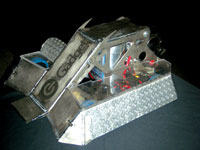
Posted to News on 20th Oct 2010, 00:00
A fight to the finish
The story of how Autodesk Inventor gave Satan's Mutt the edge in Battle of the Robots...

>It was the ultimate battle of the robots: a brand new challenger designed and built by Robo Challenge, taking on Beauty 2 - the RobotWars' European champion - and two other impressive fighting machines. Robo Challenge had to design build its robot, build the arena and organise the event for Channel 5's Gadet Show - all in just over a week.
> To make the task even more difficult, Robo Challenge would need to work to strict specifications in designing the technically advanced robot, later known as Satan's Mutt. First, the show's producers insisted that the challenger be equipped with multiple weapons rather than the one typical with most robots. Second, these weapons were to be controlled by a 'Wii-Mote' from the Nintendo Wii rather than traditional remote control technology. Third, the robot had to feature high quality armour. And fourth, it needed to have a highly distinct visual appearance.
>Robo Challenge's dedicated designer John Reid knew it was a daunting task but his first decision - choosing the design software package to carry out the work - was straightforward. In Reid's view, Autodesk Inventor was the one design tool capable of handling the complexity of the design and helping to deliver a high-quality final product to the tight deadline required.
>Reid comments: "I was immediately impressed with Inventor. It is easy to use and it makes adding dimensions and modifying parts intuitive. Being able to integrate the design data into a single digital model enables you to streamline the entire workflow without compromising on quality." Inventor played a key role at the beginning of the design process in helping Reid to rapidly create models of all the main components, including a pneumatic ram for the flipper, a gas bottle and regulator, a drive for the motors, an electronic speed controller, battery, motors for the spinner and, of course, the wheels themselves.
>It was agreed that the robot's chassis and armour should be built around the components to ensure the entire package was as small and lightweight as possible. Reid used Autodesk Inventor to evaluate all the relevant layouts - allowing for the fact that the gas bottle would need to be removed periodically for refilling. He used Inventor's Synchronous Belts Component Generator to design belts for the drive wheels and for driving the spinner.
>This enabled him to quickly locate the required mounting holes in the chassis for the wheels, taking into account available belt lengths. Once the design was completed, Reid was able to produce the files from which the physical parts of the robot could be developed. Specifically, he created drawings of all the chassis and flipper parts, exported these from Inventor as DXF files, which were then emailed to the watercutters.
> In addition, he exported models of the spinner mount and ram base to IGES files and emailed them to a team at Warwick University to be 'machined' on their CNC mills. He also created drawings of other parts of the design that were to be made manually.
> The final stage, in which the flexibility of Inventor was again key. was simulation. The concept was to run calculations within the design software that computed what the real-life reaction of the design would be to certain engineering situations.
>With this simulation process over, the final build of the robot was completed. Less than a week had elapsed between Reid receiving the brief and the raw materials and his team completing production of the robot itself. And the result? Satan's Mutt put in a starring performance on the show and ended up beating two of the three robots - including European champion Beauty 2 - to win the challenge.






